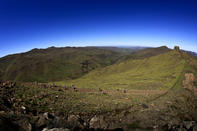Victorian-era Settlement
The town of Lady Grey was established around the development of a new church congregation. It is surrounded by the magnificent Witteberg Mountains, which are now popular for its running and hiking trails.

The Waaihoek Farm was purchased in 1856 for the erection of the church, and the settlement was named after governor Sir George Grey’s wife, Lady Grey. The church was completed in 1860 and all the houses were built to face the newly erected building. A church service was held once every month, and in 1863 the town got its first permanent reverend, Rev. David Ross. During the 1860s, the town grew substantially as it got a hotel, school, magistrates court, post office and jail. The town became a municipality in 1893 and appointed its first mayor.
During the Anglo Boer war, the town grew in population and was not really affected by the war. A railway between Lady Grey and Aliwal North was completed in 1905, and became an important trading centre. Large trading stores were set up and three more hotels were built. A Church of England and Methodist Church was built in 1906 and the Dutch Reformed Church was demolished and rebuilt in 1913. The Lady Grey dam was completed in 1925.
The Victorian-era style houses of the town still stand today, and the town has a sense of community and pride that translates into litter-free sidewalks, gorgeously restored homes and friendly atmosphere.